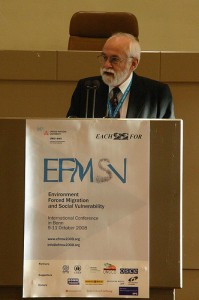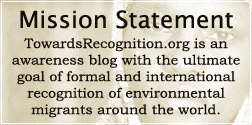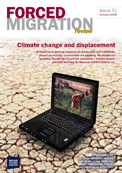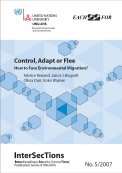 At the end of last year, the two-year long Environmental Change and Forced Migration Scenarios research project (EACH-FOR) reached its destination, concluding its 22 case studies in various countries around the world. Funded primarily by the European Commission, the EACH-FOR project aimed to investigate and measure the causes of forced migration in relation to environmental change. It also created plausible scenarios for future environmental change.
At the end of last year, the two-year long Environmental Change and Forced Migration Scenarios research project (EACH-FOR) reached its destination, concluding its 22 case studies in various countries around the world. Funded primarily by the European Commission, the EACH-FOR project aimed to investigate and measure the causes of forced migration in relation to environmental change. It also created plausible scenarios for future environmental change.
Sometime this year, EACH-FOR plans on releasing a book that outlines a number of the case studies it conducted in countries such as Bangladesh, Vietnam, and Western-Sahara. The United Nations University Institute for Environment and Human Security (UNU-EHS) and the International Organization for Migration (IOM) continue to have an active role in producing and coordinating the future publications.
The project, along with UNU-EHS, co-hosted the International Conference on Environment, Forced Migration and Social Vulnerability (EFMSV) held in Bonn, Germany last October – the largest event organized on the issue of environmental migration. The three day conference brought together research and professional communities as well as policy makers to examine and explore the links between environmental change, migration and social vulnerability. It was also the first large scale conference to discuss the sensitive and complex interplay of the above mentioned factors at a comprehensive and policy relevant level.
A press release by UNU-EHS states that there was a clear consensus during the conference – environmental migration is on the rise as the current climate is changing. “All indicators show that we are dealing with an emerging major global problem,” said Prof. Dr. Janos Bogardi, Director of UNU-EHS. The flow of migrants “will increase in coming years,” concurred Dr. Frank Laczko, head of research at IOM.
Both the EACH-FOR project and the EFMSV conference are huge leaps forward in the field, and the push for formal and international recognition of environmental migrants. In a storm of ongoing debate, the acceptance of the environment as a driver for migration bears significant progress. The challenge that now lies ahead is for it to be taken into account by the relevant policy makers for concrete action to take place.
Article by Dan DaSilva



